Nursery rhymes in a digital world
Published on: 30 Gorffennaf 2015 Author: Elizabeth Hammill
Imagine a baby or a small child beginning to discover their place in the world. Everything is new - everything unknown. The ordinary is extraordinary…the impossible possible. And words are at once 'tools for living' and magical.
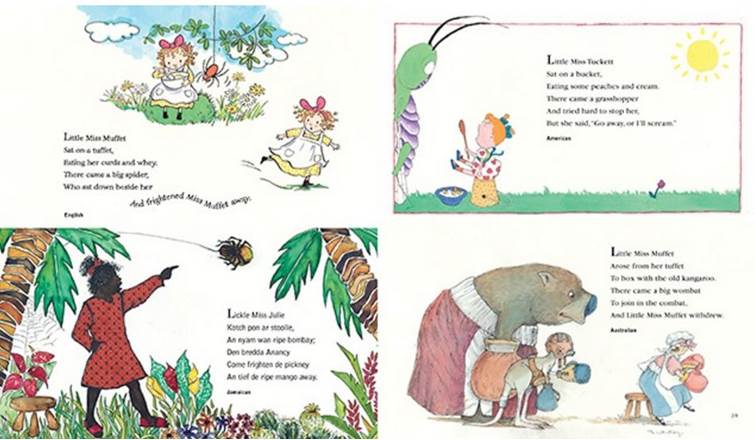
They name. They connect. They invite a sensuous response to their music, their beat, their rhythm, and their rhyme - way before they are understood. And the most magical words of all are the beloved, centuries old, words of 'Mother Goose' and her nursery rhymes.
It is Mother Goose who first introduces us to who we are in the world and invites us to become a member of the language community. As her rhymes have crisscrossed the globe begetting intriguing variants as they go, so today parallel rhymes and verses are entering and enhancing the English lexicon from the Americas, Australia and New Zealand, and in translation, from Asia, the Caribbean, African, Native and Hispanic American cultures and elsewhere.
And what a rich and vital entry into the world of language they offer - laying the foundations for a child's delight in words and sound and encouraging their ability to listen and discover how language in 'form' differs from everyday talk - how the melody, rhythm, repetitions, and cadences make meaning. Listen, for instance, to these delightful cultural variants on Little Miss Muffet as she travels to America, the Caribbean and Australia.
Are nursery rhymes in danger in our digital world?
BookTrust and National Literacy Trust surveys in 2009 and 2012 raised questions about whether Mother Goose rhymes -inhabited by kings, queens and peasants of a rural past predating electricity, television, computers, and iPads - are still relevant to 21st century children and parents. If we are so far removed from the world that hatched these rhymes, why should we still share them?
Yet from their oral roots to print to iPads to apps, Mother Goose has always been on the loose - her nursery rhymes always on the move, adapting to new times, new places. But in our digital world, are she and her fellow verse makers from cultures around the world in danger or are their rhymes alive and well?
You have only to listen to the rhymes themselves to discover that here all human life is distilled into sharp, memorable and original form - often in the shortest of short stories. Here we encounter not only our 'family album - the gathered citizens whose names and follies we have passed along over the years like backyard gossip' - and the pleasures, disasters, tragedies and slapstick comedy of everyday life but also our first make-believe. A cow jumps over the moon. Baby and i are baked in a pie. Knives and forks run away. An old woman puts her children to bed in a shoe. And our toes become pigs going to market and our fingers are told to 'Wake up!' Nonsense or 'magic realism'? A wonderful awakening for our imaginations and the possibilities for word play too. Listen to these nonsensical counting out rhymes inspiring a young artist to create an imaginative world that reveals facets of four cultures in a riot of colour, life and fun.
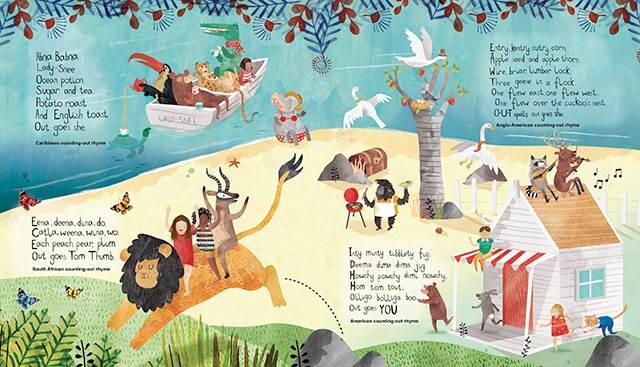
Lullabies around the world
Then there are rhyming alphabets, counting rhymes, rhymes about days of the week, the months, the seasons, holidays as well as riddles, games and amusements. The oldest of all are the lullabies sung universally to soothe the youngest to sleep. The first recorded lullaby dates from Babylonian times. We all know 'Hush-a-bye baby' but listen to this beautiful lullaby from the Akan people of Ghana in which a mother sings of her love for her baby: 'Someone would like to have you for her child but you are mine'.
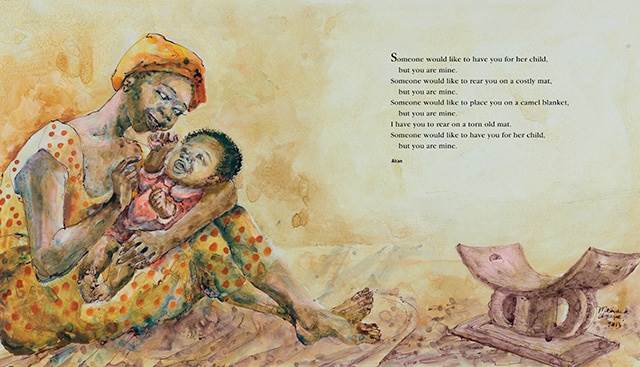
Or these two popular traditional lullabies - one a 'hush song' from the pre-Civil War American South, the other a New Zealand Maori 'slumber song'
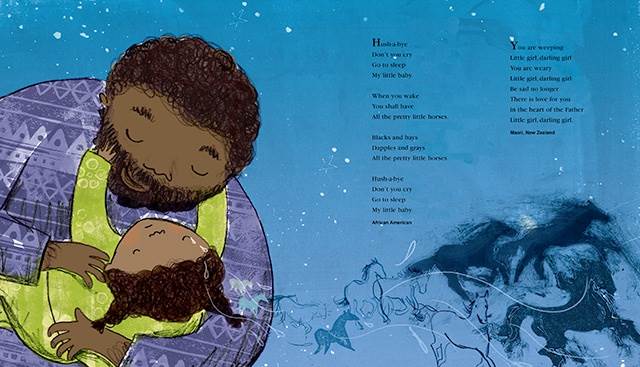
Or this dreamy, other worldly American lullaby.
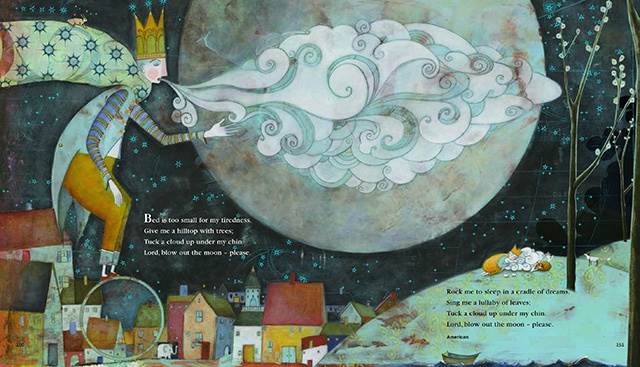
Wherever in the world we live, we recognise the feelings, warmth and sense of closeness generated by these lullabies. They belong to all of us and are part of a tradition that has been shared over generations.
Re-envisioning nursery rhymes
The noted New Zealand bookseller and teacher Dorothy Butler wrote in Babies Need Books : 'Don't even consider parenthood without a really good collection' of nursery rhymes. Today, there are innumerable collections to choose from. Most contain the well-known traditional English Mother Goose rhymes illustrated by artists like Harold Jones, Raymond Briggs and Nicola Bayley. But others, sometimes in single culture collections, are beginning to reflect and celebrate the wonderful multiplicity of 'infant songs' and voices that speak to the young in verse in Britain and elsewhere today.
The verses quoted here come from Over the Hills and Far Away, a collection that breaks out of the traditional mould and marries old Mother Goose favourites with verse from across the English speaking world - some newly translated. Here children from many backgrounds can find themselves in words and pictures. Seventy-seven artists from around the world created artwork for a double spread and a rhyme or group of verses. Here culture, verse, artist and style meet, and so, to turn a page is to enter another world and often discover how much we share in common.
Just as rhymes today may be being re-visioned to create visual and interactive digital experiences for the youngest, so too is the printed nursery collection being re-visioned to reflect the diverse culture and world that we live in.
Surround your baby or child with jingles and rhymes
As a parent or carer, if you share rhymes, you will discover that your baby or toddler loves them - indeed revels in the rhythm, rhyme and sometimes, the lunacy too. Nursery rhymes, far from simply being 'good for the child' and their subsequent language development as educationalists assert, have stuck around as long as they have because they really and truly do speak to them.
Surround your baby or child with jingles and rhymes. Encourage their delight in rhythm and rhyme. Explore the power of words and pictures to open wide our imaginations to the wide world and its possibilities. And as the sun sets, gather together for some family bedtime rhymes, as the Native American mothers and children gather in the Sonoran Desert in Arizona, to listen, 'in the blue night that is settling', to a Tohono O'odham storyteller who wonders: 'How shall I begin my song,..'
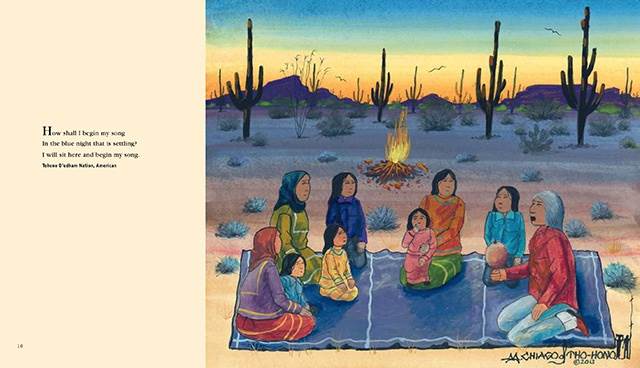
Topics: 0-1 year, 2-3 years, 4-5 years, Fairy tale, Poetry/rhyme, Classics, Around the world, Features






Add a comment